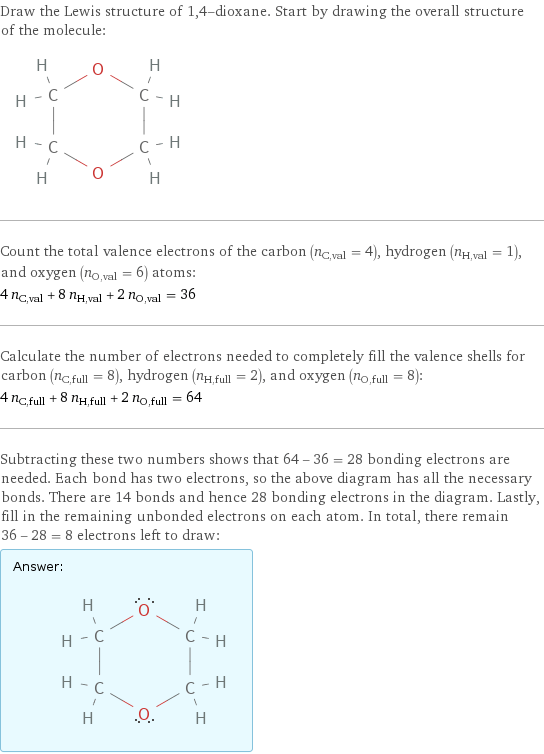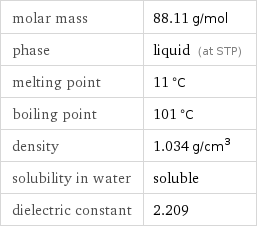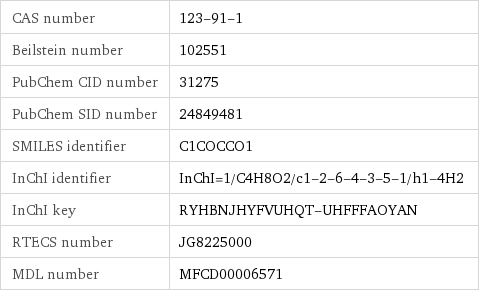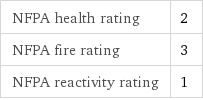Input interpretation

1, 4-dioxane
Chemical names and formulas

formula | C_4H_8O_2 name | 1, 4-dioxane alternate names | 1, 4-diethylene dioxide | diethylene dioxide | diethylene ether | diethylene oxide | dioxane mass fractions | C (carbon) 54.5% | H (hydrogen) 9.15% | O (oxygen) 36.3%
Lewis structure

Draw the Lewis structure of 1, 4-dioxane. Start by drawing the overall structure of the molecule: Count the total valence electrons of the carbon (n_C, val = 4), hydrogen (n_H, val = 1), and oxygen (n_O, val = 6) atoms: 4 n_C, val + 8 n_H, val + 2 n_O, val = 36 Calculate the number of electrons needed to completely fill the valence shells for carbon (n_C, full = 8), hydrogen (n_H, full = 2), and oxygen (n_O, full = 8): 4 n_C, full + 8 n_H, full + 2 n_O, full = 64 Subtracting these two numbers shows that 64 - 36 = 28 bonding electrons are needed. Each bond has two electrons, so the above diagram has all the necessary bonds. There are 14 bonds and hence 28 bonding electrons in the diagram. Lastly, fill in the remaining unbonded electrons on each atom. In total, there remain 36 - 28 = 8 electrons left to draw: Answer: | |
3D structure

3D structure
Basic properties

molar mass | 88.11 g/mol phase | liquid (at STP) melting point | 11 °C boiling point | 101 °C density | 1.034 g/cm^3 solubility in water | soluble dielectric constant | 2.209
Hydrophobicity and permeability properties

predicted LogP hydrophobicity | -0.22 predicted LogS | 0.51
Basic drug properties

approval status | experimental | small molecule
Liquid properties (at STP)

density | 1.034 g/cm^3 vapor pressure | 27 mmHg dynamic viscosity | 0.001177 Pa s (at 25 °C) surface tension | 0.03086 N/m refractive index | 1.422 UV cutoff wavelength | 215 nm
Units

Thermodynamic properties

specific heat capacity c_p | liquid | 17.263 J/(g K) molar heat capacity c_p | liquid | 1521 J/(mol K) specific heat of formation Δ_fH° | gas | -3.579 kJ/g molar heat of formation Δ_fH° | gas | -315.3 kJ/mol molar heat of vaporization | 37.5 kJ/mol | specific heat of vaporization | 0.426 kJ/g | molar heat of combustion | 2362 kJ/mol | specific heat of combustion | 26.81 kJ/g | molar heat of fusion | 12.84 kJ/mol | specific heat of fusion | 0.1457 kJ/g | critical temperature | 587 K | critical pressure | 5.21 MPa | (at STP)
Chemical identifiers

CAS number | 123-91-1 Beilstein number | 102551 PubChem CID number | 31275 PubChem SID number | 24849481 SMILES identifier | C1COCCO1 InChI identifier | InChI=1/C4H8O2/c1-2-6-4-3-5-1/h1-4H2 InChI key | RYHBNJHYFVUHQT-UHFFFAOYAN RTECS number | JG8225000 MDL number | MFCD00006571
NFPA label

NFPA label

NFPA health rating | 2 NFPA fire rating | 3 NFPA reactivity rating | 1